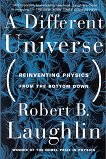Laughlin gives his take on “fundamental” physics. It’s not all grand unified theories, and untestable new mathematical models: it’s emergent properties of large numbers of particles acting collectively. He has about the best scientific background possible to discuss these points, having won a Nobel Prize in physics. So his story is peppered with examples of supeconductivity, superfluidity, crystalline phonons, and more. He makes the point that you can spot an important emergent property because it is independent of small flaws in the substrate: the crystal does not have to be absolutely perfect, the superconductor does not have to be absolutely pure. This is an advantage: the properties are insensitive to the substrate, so you can investigate the properties easily. This is also a disadvantage: the properties are insensitive to the substrate, so you can’t draw conclusions about the substrate from them. And since, in Laughlin’s picture, many of the observed properties of fundamental particles are actually such emergent properties, so much the worse for deducing properties of the fundamental particles themselves.
This is all very important and very interesting. But unfortunately, it is difficult to get to grips with it from this book. When Laughlin does talk about the physics, it is fascinating. But he has the unfortunate habit of talking about everything but the physics. The text is littered with loads of little anecdotes. Some are interesting; Laughlin appears to believe them all to be illuminating. I suspect that, if you already understand the point he is trying to make, they may be. Rather like all those smug little Zen koans that are comprehensible only once you have reached enlightenment (I am told). But however much Zen enlightenment may need to be reached without explicit guidance, scientific enlightenment is different.
He explains that he was compelled to write this book after one too many a conversation about Brian Greene’s view of physics as laid out in The Elegant Universe, a view with which he deeply disagrees. Ironically, the book I read immediately before this one was Greene’s follow up, The Fabric of the Cosmos. As I say in my review of Greene’s first book, he puts over mind-wrenchingly difficult concepts with stunning clarity, demonstrating that it is possible to write a pop-science book without leaving out the science. Unfortunately, Laughlin does not do the same, which is a pity, because these ideas are extremely important, and need to be done much better justice. This is worth reading because of the important ideas, but I hope Laughlin writes a follow up, concentrating on the physics, and eschewing the “illuminating” anecdotes.
